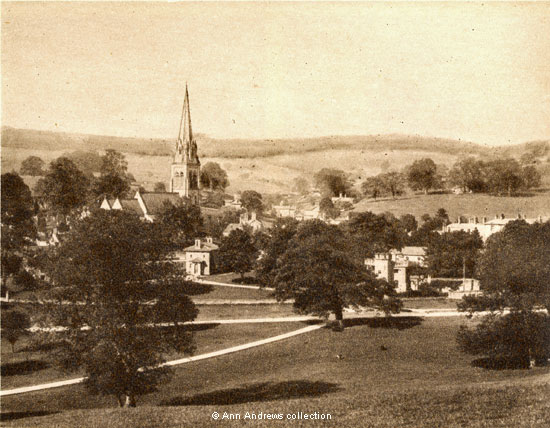Edensor Church, designed by Sir George Gilbert Scott and completed
in 1867, replaced an ancient structure. The earliest mention
of it was in an undated deed made in the time of William
Earl of Derby who lived in the reign of King Henry II[1],
so in a document written between 1216 and 1272.
The top photograph of St. Peter's Church is from a carte de
visite that was taken by the Matlock Bath photographer William
Potter, probably in the 1890s. One's eye is immediately drawn
to the distinctive broached spire on top of the tower at the
west end of the church. The spire itself is octagonal and made
up of eight triangular faces (broaches).
When Sir Joseph Paxton was buried in
the churchyard in 1865 "The
Derby Mercury" reported that the "The ancient
church, long crumbling under the weight of years, was removed
about a year ago, and the new edifice which the present Duke
of Devonshire is about to erect at a cost of about 10,000li [£10,000]
is just rising above the foundations"[2].
Paxton had lived in the neighbourhood for nearly 40 years
and was best known as the architect of the Crystal Palace,
designed for the Great Exhibition of 1851. His funeral was
supposed to be a quiet affair, but there were over thirty
private carriages following the hearse and six mourning
coaches. Amongst those attending was the then Duke of Devonshire
and his three sons. The brass plate on Sir Joseph's coffin
was inscribed with the words:
Sir Joseph Paxton, M.P. Died June 8, 1865,
in the sixty second year of his age.[2]

Edensor, the Graceful Spire |
The church is Victorian Gothic, in the Decorated style.
Many pieces from the old church were preserved in the new
building and included a brass plate, written in Latin,
dedicated to John Beton who had served Mary Queen of Scots.
He'd been employed as Taster and then as Comptroller of
the Household. "In conjunction with others he bravely
liberated the most Serene Queen from the chains of a most
truculent tyrant at the castle of Loch Leven"[1].
In the north aisle is a large monument to two of Bess
of Hardwick's sons, Henry (d.1616)
and William (d.1625) Cavendish,[1] and
a window in the eastern chapel dedicated to Lord Frederick
Cavendish who was murdered in Phoenix Park, Dublin, in
1882[3]. Kathleen
Cavendish ("Kick", nee Kennedy), widow of the
Marquess of Hartington who was killed in 1944, was buried
at Edensor and, more recently, Andrew, 11th Duke of Devonshire,
was interred at St. Peter's in 2004[4].
In the churchyard is the tomb of:
William Spencer Cavendish, Sixth Duke of Devonshire,
Born May 21, 1790. Died 18 January, 1858.
There is more about Edensor in:
 Derbyshire's Parishes,
1811, Parishes E - G Derbyshire's Parishes,
1811, Parishes E - G
 Kelly's Directory of Derbyshire, 1891 - Edensor Kelly's Directory of Derbyshire, 1891 - Edensor
|
References:
[1] Cox, J Charles (1877) "Notes
on the Churches of Derbyshire, Vol 2, Hundred of the High Peak
and Hundred of Wirksworth", Chesterfield: Palmer and
Edmunds, London: Bemrose and Sons, 10 Paternoster Buildings;
and Derby. Cox translated the Latin inscription of the Beton
memorial plate.
[2] "The Derby Mercury",
21 June 1865. Burial of Sir Joseph Paxton.
[3] Mee, Arthur (ed.) (1937) "Derbyshire:
The Peak Country",The King's England Series, Hodder
and Stoughton Limited, London.
[4] Devonshire, Deborah (2010) "Wait
for Me" published by John Murray. ISBN (of paperback)
978-1-84854-191-7. |